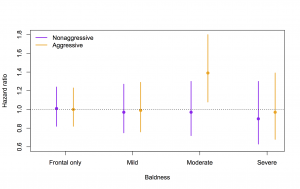Bald truth
From the Herald
Men who are bald at age 45 are more likely to develop aggressive prostate cancer compared with those who keep their hair.
US researchers found those who lose hair at the front of their heads and have moderate hair-thinning on the crown were 40 per cent more likely to develop a fast-growing tumour in their prostate.
This was compared with men with no baldness.
That’s all true, but what casts doubt on this finding is that you get the same results if you compare to men with severe baldness. That is, the research found a higher rate of aggressive prostate cancer in men who had ‘moderate’ baldness on the top of head, but not in those who had milder or more severe forms, and no increase in non-aggressive prostate cancer. Here are the estimated relative increases in risk, with confidence intervals
When you consider the lack of a consistent trend, and the fact that the evidence isn’t all that strong for the moderate-baldness/aggressive-cancer combination, I don’t think this is worth getting all that excited about.
This one can mostly be blamed on the journal: the American Society of Clinical Oncology press release isn’t too bad in itself, but if you compare it to the other recent occasions when ASCO have issued a press release, it doesn’t really measure up.
Thomas Lumley (@tslumley) is Professor of Biostatistics at the University of Auckland. His research interests include semiparametric models, survey sampling, statistical computing, foundations of statistics, and whatever methodological problems his medical collaborators come up with. He also blogs at Biased and Inefficient See all posts by Thomas Lumley »

Are there examples of similar non-monotonic correlations in health that are known to be real?
10 years ago
There’s pretty good evidence for J-shaped non-monotone risk with alcohol consumption, and definitely the risk of death is non-monotone with weight. But if the non-monotone association is real, the explanation is wrong.
10 years ago
I should also have noted that this story is from the Daily Mail, and is related to their twin obsessions of sex and cancer.
10 years ago
Playing devil’s advocate… the confidence interval for moderate hair loss is pretty small for an interaction term in a model. It means they had a reasonable sample size.
And there could be two modes of hair loss – one mode means hair is lost early through genetic disposition but not associated with prostate cancer; another mode that is hormonal, associated with fluctuating testosterone levels in middle age with might be connected with prostate cancer.
On the other hand, there is huge room here for measurement errors in terms of classifying hair loss and tumor type.
10 years ago
It could be true, yes, and there’s nothing wrong with it as a scientific publication. There’s not enough evidence to be marketing it as major news, though.
10 years ago